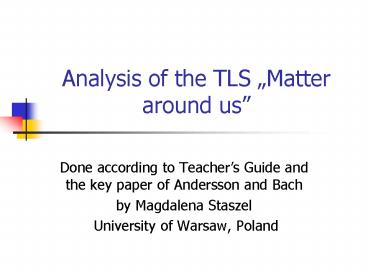Analysis of the TLS Matter around us - PowerPoint PPT Presentation
1 / 10
Title:
Analysis of the TLS Matter around us
Description:
Analysis of the TLS 'Matter around us' Done according to ... of Democritus to quarks: ... with atoms of Democritus, to modern understanding within ... – PowerPoint PPT presentation
Number of Views:50
Avg rating:3.0/5.0
Title: Analysis of the TLS Matter around us
1
Analysis of the TLS Matter around us
- Done according to Teachers Guide and the key
paper of Andersson and Bach - by Magdalena Staszel
- University of Warsaw, Poland
2
Points to consider
- Integration of several subjects
- List of contents
- Motivation for teaching selected content
- Content in curriculum
- History of ideas in this area
- Research-based pupils conceptions
- Suggestion for a number of lessons
- Assessment of pupils conceptual understanding
- pre-test, post-test, formative assessment
3
Subjects integrated in the TLS
- Physics
- Chemistry
- Biology /Environmental science
- Mathematics (basis of them all)
- Elements of geography
4
List of contents of the TLS
- Why teach about the structure of matter
- From atom of Democritus to quarks history
- Teaching goals and teaching contents the Polish
curriculum - Interdisciplinary character of the TLS
- The most common pupils difficulties and everyday
conceptions - Realization of the sequence the tools
- Selection of experiments
- Selection of questions and problems
- Bibliography
- Teaching proposals
5
Motivation for teaching about structure of matter
- Kinetic model of matter has both
- - simplicity
- and
- - giant predictive power,
- Allows pupils to understand also environmental
problems!
6
Content in the Polish curriculum
- Physics properties of matter states of
aggregation of matter kinetic model of the
structure of matter. - Chemistry Chemical substances and bodies in in
mans environment mixtures of substances
chemical element and chemical compound physical
phenomena and chemical changes discrete characte
of the structure of matter atoms of elements,
molecules of compounds as molecular entities.
Reactions of synthesis, decomposition and
exchange (microscopic description) atomic and
molecular mass. - Biology/ Environment the ways of transporting
water, mineral solutions and sap in plantsthe
structure and role pf blood vessels influence of
environmental pollution on plants and animals
hydrological cycle causes of water pollution - Mathematics operations on rational numbers
integer exponent calculating areas and volumes
of solids
7
History of ideas
- A concise review of development of our views on
the structure of matter, starting with atoms of
Democritus, to modern understanding within the
Standard model, is presented.
8
Pupils everyday conceptions
- There is a confusion in pupils minds between two
measures of the amount of matter mass and
volume - Pupils have problems with distinguishing a
physical body from a chemical substance - Pupils do not distinguish between processes of
physical changes and of chemical reactions - Pupils believe that atoms and/or molecules are
immersed in other matter, e.g. there is air
between molecules - Pupils ascrobe to atoms/molecules properties of
macroscopic bodies of which they are part (e.g.
molecules of a hot body are hot,..) - When interpreting physical and chemical phenomena
the same features and processes are ascribed to
molecules that we observe for macroscopic bodies
and substances (molecules expand when a body is
heated).
9
Lessons in the sequence
- 1-2. Matter, chemical substances and physical
bodies in the human environment - 3. Physical processes and physical phenomena.
Chemical reactions - 4-5.Mixtures vs. chemical reactions
- 6-7.Discrete character of matter.
Kinetic-molecular theory of matter. - 8. Surface tension, molecular interactions.
Chemical bonds - 9. States of aggregation of matter
- 10-11. Density of a substance
- 11-12. Thermal expansion of solids, liquids and
gases
10
Assessment of pupils conceptual understanding
- Pre-test
- Post-test (part 1 and 2 in the second part
pupils have to choose one of the questions and
explain the answer they have given) - Formative assessment































